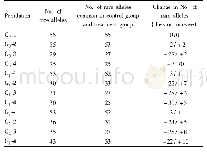《Table 6 Change of Number of rare alleles of the tested soybean germ-plasm populations by SSR》
 提示:宽带有限、当前游客访问压缩模式
提示:宽带有限、当前游客访问压缩模式
本系列图表出处文件名:随高清版一同展现
《Effects of Seed Vitality and Regeneration on Genetic Integrity in Soybean by SSR Markers》
A rare allele refers to an allele within a population whose gene frequency is less than 5%.The genetic diversity within a population is largely due to the binding or integration of rare alleles(P<0.05)into the genotype background.Soybean germplasm materials are prone to loss or increase of rare alleles after aging treatment and reproduction and regeneration,resulting in changes in the number of alleles in population.The changes in the number of rare alleles within various populations are shown in Table 6.Itcould be seen from Table 6 that in the original materials(G0),populations G0-3 and G0-4 with a germination rate of 81.0%and79.0%,respectively,had significantly fewer rare alleles than the control population G0-1,the number of rare alleles shared with the control population G0-1 decreased with the decrease of vitality level,and the number of lost/increased alleles also had the same trend.However,population G0-2 with a germination rate of95.0%had no big differences in above three indicators from the control population G0-1,indicating that the decline in vitality can significantly affect the number of rare alleles in the soybean germplasm population,mainly to reduce its number.Compared with G0-1,its first and second reproduced populations G1-1 and G2-1had smaller changes in the above three indicators,indicating that the soybean germplasm material with a germination rate of 98.0%had its rare alleles well maintained after two times of reproduction and regeneration.However,populations G1-2,G1-3,G1-4 which were regenerated from populations G0-2,G0-3 and G0-4,respectively,and populations G2-2,G2-3 and G2-4 which were regenerated from populations G1-2,G1-3,and G1-4,respectively,showed number of rare alleles significantly lower than the control population G0-1,and the number of rare alleles shared with the control population G0-1 showed the same trend,while the number of lost/increased rare alleles increased significantly,indicating that the progeny populations reproduced from the populations with germination rates of 95.0%,81.0%and 79.0%had larger changes in the number of rare alleles than the control population.The above analysis shows that the decline in vitality has a higher effect on the change in number of rare alleles than reproduction generation.
| 图表编号 | XD0027994400 严禁用于非法目的 |
|---|---|
| 绘制时间 | 2019.02.01 |
| 作者 | Dong WANG、Xiaodong ZHANG、Runfang LI、Lingyun LU、Xiaomu WANG、Xiaohong GU、Xia XIN、Guangkun YIN、Xinxiong LU、Hanfeng DING |
| 绘制单位 | Crop Germplasm Resource Center of Shandong Province、Shandong Research Station of Crop Gene Resource & Germplasm Enhancement,Ministry of Agriculture、Crop Germplasm Resource Center of Shandong Province、Shandong Research Station of Crop Gene Resource & Germp |
| 更多格式 | 高清、无水印(增值服务) |
查看“Table 6 Change of Number of rare alleles of the tested soybean germ-plasm populations by SSR”的人还看了
-

- 表2 色那铜金矿床侵入岩稀土元素测试结果 (10-6) Tab 2 Test Results of Rare Earth Elements in the Intrusive Rocks of Sena Copper Gold Deposit





